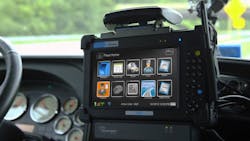Trucking firms need to view the mandate for installing electronic logging devices (ELDs) as an information technology (IT) investment, one that requires careful screening of ELD vendor history, capabilities, and contract language, argues an industry expert.
“I would encourage motor carriers to look at this as IT purchase; it really is a major IT investment,” said Annette Sandberg, managing partner of TransSafe Consulting LLC, during a webinar this week hosted by Fleet Owner and sponsored by telematics firm Telogis.
“Pick ELDs like you would for any other major IT investment,” she stressed during the Getting it Right: A Guide to ELD Implementation online event. “You need to ask your provider how long they’ve been in business, find out how financially sound they are, determine how many existing customers they have, and especially how long they’ve worked in the trucking market.”
Sandberg – who served as administrator of the Federal Motor Carrier Safety Administration (FMCSA) from 2003 to 2006 and as deputy administrator of the National Highway Traffic Safety Administration (NHTSA) – added that one or two truck fleets probably don’t need to send out a formal request for proposal (RFP) where ELDs are concerned, but that larger carriers should think about doing so; asking for bids and writing down they specific things they want an ELD to provide.“Develop a systemic approach,” she emphasized. “Sit down and write out the requirements you want your [ELD] system to have; ‘This is what we want to do and how to do it.’ The pass that around among your personnel: drivers, dispatchers, safety managers, terminal managers and especially the back office. I doubt if any one system will meet all of your requirements but it should meet most of them.”
Sandberg especially cautioned fleets “not be fooled by bells and whistles” when it comes to ELDs.
“Be able to do a little deeper dive into the technology,” she said. “One carrier ran pilot [ELD] tests with veteran drivers for a month to work the kinks out, including dispatchers in that process. You need to do due diligence to find out how it works, so consider testing at least two or three [ELD] systems.”
Back office functionality in terms of managing ELD data is a critical and often overlooked part of this process, Sandberg added.
“I am real picky about this part,” she stressed. “You need ways to slice and dice all the data [from ELDs] because if it does not do that for you, it will not helpful in long run.”
In particular, Sandberg said easy access to ELD data should allow fleets to “pass audits in a breeze and get [inspectors] out door” quickly with everything they need. “If there a lot of questions about the data, that will cause FMCSA [inspectors] to stay in your operation longer. So spend a lot of time looking at the back office [part of an ELD] system.”
A few other items Sandberg noted in her discussion:
- Fleets should carefully consider their contracts with ELD providers. “Go over every detail,” she said
- Data storage requirements are a critical contract point. “There may be hidden costs for data transfers or storage fees for keeping electronic logbooks for additional time periods,” Sandberg said. “Right now ELD data is required to be kept for six months. But if you need to keep it longer, say for a legal case, are there fees for that?”
- There should be provisions in the contract covering what happens if your ELD provider is declared “non-compliant” by FMCSA, she noted. “There should be an obligation by them to the carrier should something happen to their certification; a way to remediate the situation, etc.”
- Talk to current customers of your potential ELD provider. “They will tell you if your provider understands the trucking business and its rules and its customer service performance,” Sandberg said. “You want to know if you can reach them at 2 a.m. if something goes wrong.”
About the Author
Sean Kilcarr
Editor in Chief
Sean Kilcarr is a former longtime FleetOwner senior editor who wrote for the publication from 2000 to 2018. He served as editor-in-chief from 2017 to 2018.

